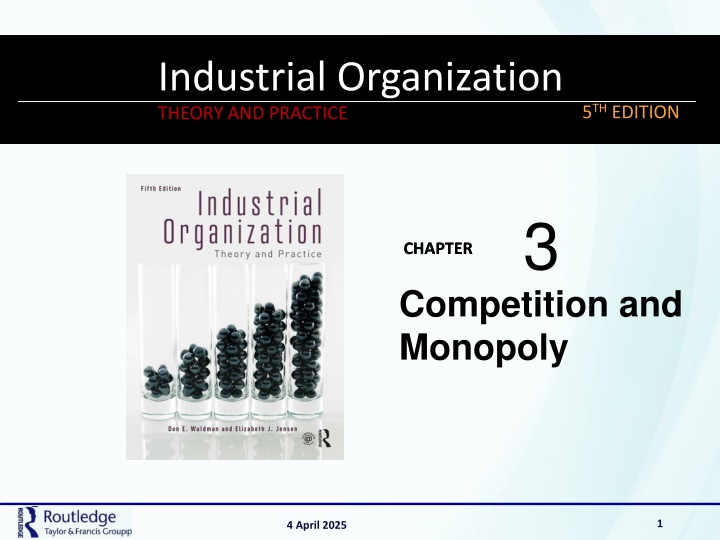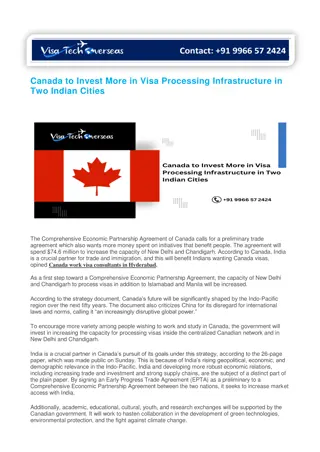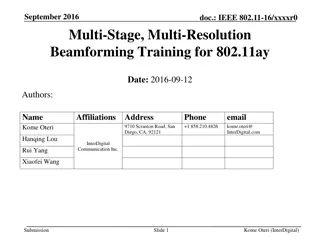Health Canada's Multi-Year Mental Health Strategy Update
Providing updates on the implementation progress of Health Canada's Multi-Year Mental Health and Wellness in the Workplace Strategy and Federal Public Service Workplace Strategy, focusing on key pillars, strategic objectives, accomplishments, and initiatives to promote mental health and well-being in the workplace.
Download Presentation

Please find below an Image/Link to download the presentation.
The content on the website is provided AS IS for your information and personal use only. It may not be sold, licensed, or shared on other websites without obtaining consent from the author.If you encounter any issues during the download, it is possible that the publisher has removed the file from their server.
You are allowed to download the files provided on this website for personal or commercial use, subject to the condition that they are used lawfully. All files are the property of their respective owners.
The content on the website is provided AS IS for your information and personal use only. It may not be sold, licensed, or shared on other websites without obtaining consent from the author.
E N D
Presentation Transcript
MODERN LABOR ECONOMICS THEORY AND PUBLIC POLICY THEORY AND PRACTICE Industrial Organization 12THEDITION 5THEDITION 3 CHAPTER CHAPTER Competition and Monopoly 1 4 April 2025
3.1 The Economics of Perfect Competition 3.1.1 The Assumptions of Perfect Competition 1. Large number of buyers and sellers, each small relative to total purchases or sales in the market. 2. Homogeneous (identical) product, so that consumers are indifferent about suppliers. 3. Perfect information: all economic agents (firms and consumers) have all of the information they need to make economic decisions. 4. No transaction costs for both buyers and sellers. 5. No barriers to entry or exit. Implies that both firms and consumers are price takers. Since consumers have perfect information about prices, any firm that raises its price above the market price will not sell any output. No perfectly competitive firm has any incentive to price below the market price because it can sell as much output as it wants at the going price. Likewise, no buyer is large enough to influence the market price and take price as given. 4 April 2025 2
3.1 The Economics of Perfect Competition 3.1.1 The Assumptions of Perfect Competition Figure 3.1 shows the demand curve facing a perfectly competitive firm. The vertical portion of the demand curve reflects the firm s belief that it will sell nothing if it charges a price higher than the market price of $2 The horizontal portion of the demand curve shows that the firm can sell whatever amount it wants if it charges the market price. The price elasticity of demand is a measure of how sensitive quantity demanded is to a change in price. Defined as the percentage change in quantity demanded divided by the percentage change in price. The higher the absolute value of the elasticity of demand, the larger the change in quantity resulting from a change in price. 4 April 2025 3
3.1 The Economics of Perfect Competition 4 April 2025 4
3.1 The Economics of Perfect Competition 3.1.2 The Firm s Supply Curve The profit-maximizing rule tells a firm to produce that quantity of output for which marginal revenue equals marginal cost. For a firm in a perfectly competitive industry, marginal revenue always equals price. A perfectly competitive firm can always sell another unit of output without having to lower its price. Revenue = pQ, so the change in revenue from selling one more unit is always equal to p. If a perfectly competitive firm wants to produce a positive quantity of output, it will choose the level for which price equals marginal cost. Sometimes a firm may choose not to produce any output. To understand why, it is necessary to analyze the firm s supply decision in both the short run and the long run. 4 April 2025 5
3.1 The Economics of Perfect Competition 3.1.2 The Firm s Supply Curve Short Run A firm should produce in the short run if its total revenue is greater than or equal to its avoidable costs. Consider first the case in which all fixed costs are sunk so the only avoidable costs are the firm s variable costs. Fixed costs must be paid whether or not the firm produces zero. In the short run, therefore, a profit-maximizing firm will choose to produce some output as long as the revenue it gets from selling that output is greater than or equal to the costs of the variable inputs it must hire to produce that output. TR VC, or P AVC. The point at which P = AVC is called the shutdown point and is the minimum point on the AVC curve. In the short run, a perfectly competitive firm will produce the output for which P = MC as long as P AVC. 4 April 2025 6
3.1 The Economics of Perfect Competition 3.1.2 The Firm s Supply Curve Short Run, continued. Figure 3.2 shows the firm s short-run supply curve. P0 is the shutdown price for the firm; above P0 the short-run supply curve is the marginal cost curve. Note that for prices below P1 but above P0 the firm produces output in the short run even though its economic profits are negative. Economic profits are shown as the area of a rectangle with length equal to the quantity of output being produced and width equal to the difference between price and average cost at that quantity. For example, profits at q2 equal the shaded rectangle in Figure 3.2. If some fixed costs are avoidable, the shutdown point would be above minimum average variable cost (= min ATC if all fixed cost are avoidable). 4 April 2025 7
3.1 The Economics of Perfect Competition 3.1.2 The Firm s Supply Curve Long Run In the long run, all inputs are variable. A firm will leave an industry if it is earning negative economic profits. A profit-maximizing firm will produce only if TR TC (P ATC). The firm s long-run supply curve is simply its long-run marginal cost curve above the minimum point on the long-run average total cost curve. For any price above the minimum point on the average total cost curve, the firm will earn positive economic profits. For any price below this minimum, the firm will not produce in the long run. 4 April 2025 8
3.1 The Economics of Perfect Competition 3.1.3 The Market Supply Curve and Equilibrium The short-run market supply curve is derived by choosing a price and adding up the quantities of output produced by each firm at that price. The number of firms in the industry in the short run is fixed. Market equilibrium is the intersection of the market demand and market supply curves. In the short run a perfectly competitive firm may be making positive, negative, or normal (zero) economic profits. In Figure 3.3, for example, the firm is earning positive economic profits because P > ATC. Profits are shown as the shaded rectangle in Figure 3.3(a). 4 April 2025 9
3.1 The Economics of Perfect Competition 3.1.3 The Market Supply Curve and Equilibrium Because resources are mobile, however, no firm can make either positive or negative economic profits in the long run. Positive profits induce entry, which increases supply and reduces price, whereas negative profits cause firms to leave. Exit decreases supply and increases price. In long-run equilibrium, therefore, price must equal average cost so that economic profits equal zero. That price is also equal to SRMC and LRMCt at the profit-maximizing level of output for the perfectly competitive firm. The long-run equilibrium price must thus equal P* where SRMC, LRMC, SRAC, and LRAC are all equal. 4 April 2025 10
3.1 The Economics of Perfect Competition 3.1.4 Properties of Competitive Equilibrium The equilibrium resource allocation in a competitive economy is efficient, meaning that no possible reallocation of resources will make one market participant (consumer or firm) better off without hurting another. All mutual gains from trade have been achieved. Efficiency in the level of output, called allocative efficiency, requires that the marginal benefit (MB) of producing another unit of output equal its marginal cost. If MB > MC is greater than marginal cost, too little of the good is being produced. If MB < MC, too much is being produced. In competitive equilibrium, price, which represents the marginal benefit to the consumer, equals the marginal cost to society of producing that last unit. Thus the socially optimal quantity of the good is produced. 4 April 2025 11
3.1 The Economics of Perfect Competition 3.1.4 Properties of Competitive Equilibrium Competitive equilibrium also exhibits efficiency in production. In long-run equilibrium each firm is producing at the minimum point on its long-run average cost curve. Output is produced using the least costly combination of inputs. High-cost firms will be forced to exit the market, so resources are not wasted through inefficient production. A third characteristic of competitive equilibrium is that each perfectly competitive firm earns zero economic profits in long-run equilibrium. Productive resources receive only their opportunity cost and nothing more. The perfectly competitive model serves as a valuable reference point because of the desirable properties of long-run equilibrium. 4 April 2025 12
3.2 Introduction to Welfare Economics To study the economic cost of a departure from perfect competition, economists use the two related concepts of consumer surplus and producer surplus. Consumer surplus is the difference between the maximum amount consumers are willing to pay for a good and the amount they actually pay. Area bounded above by the market demand curve and below by the market price, as shown by triangle ABC in Figure 3.5. Note that no consumer surplus is associated with the fiftieth unit of output; that unit of output would not be purchased at any price higher than $40. For the demand curve pictured in Figure 3.5, consumer surplus equals (50)($80- $40) = $1000. 4 April 2025 13
3.2 Introduction to Welfare Economics Producer surplus is the difference between the market price the producer receives for selling a unit of output and its reservation supply price, the lowest price for which firms would be willing to produce. Because the supply curve represents the marginal cost of producing, producer surplus is the area to the left of the supply curve, bounded above by the market price. This is shown in Figure 3.5 as triangle BCD; producer surplus equals (50)($40- $20) =$500, the area of the triangle. 4 April 2025 14
3.3 The Economics of Monopoly 3.3.1 The Relationship Between Marginal Revenue and Price A monopoly is the sole producer of a good for which there are no close substitutes. A monopolist is the entire industry and faces the market demand curve for its product. Since demand slopes downward, the monopolist can choose a high price and sell a relatively small quantity of output, or it can choose a lower price and sell more output. A monopolist will choose to produce the quantity for which MR=MC, but MR P. Because demand is downward-sloping, the only way it can sell an additional unit of output is by lowering the price on all units. Gains revenue from the additional unit of output Loses revenue on those units previously sold at a higher price. Thus MR < P. 4 April 2025 15
3.3 The Economics of Monopoly 3.3.1 The Relationship Between Marginal Revenue and Price Figure 3.6 shows the trade-off faced by a monopoly. At P1 the monopoly sells Q1 units of output. Total revenue is the area of the rectangle OP1AQ1 To sell (Q1 +1) the monopolist must lower price to P2 The monopoly gains area Q1CB(Q1+1) (= P2) in total revenue. The monopoly also loses area P1ACP2, the original quantity sold times the change in price. Marginal revenue is the sum of the two areas. Thus for a monopoly, MR < P. 4 April 2025 16
3.3 The Economics of Monopoly 4 April 2025 17
3.3 The Economics of Monopoly 4 April 2025 18
3.3 The Economics of Monopoly 4 April 2025 19
3.3 The Economics of Monopoly 3.3.2 Elasticities, the Degree of Market Power, and the Lerner Index The Lerner Index (LI) shows that even a monopolist has only limited control over price. If the price elasticity of demand is high (very elastic), as in Figure 3.8(a), then a monopolist s profit-maximizing price is still relatively close to its marginal cost. And LI is small. A less elastic demand curve such as that shown in Figure 3.8(b) results in a larger monopoly markup and a larger LI. 4 April 2025 20
3.4 Welfare Comparison 4 April 2025 21
3.4 Welfare Comparison Deadweight loss reflects the potential surplus that would have gone to some group consumers or producers under perfect competition. Measures the misallocation of resources due to monopoly. Area CEFH, the excess monopoly profit, is a transfer from one group (consumers) to another (the monopolist), but is not a loss of social welfare. Important to understand that this problem arises because the monopoly price is greater than the marginal cost of the good. Even though consumers would be willing to pay more for an additional unit of the good than it would cost society to produce that unit, the monopolist does not produce it. 4 April 2025 22
3.4 Welfare Comparison 4 April 2025 23
3.4 Welfare Comparison 3.4.1 Measurement of the Costs of Monopoly Power Critics assert that: Harberger s assumed price elasticities of demand were too low His assumed competitive rate of profit was too high Using industry profit rates causes an aggregation bias by averaging high monopoly profit rates with losses of other firms in the industry. Some of the revised estimates put the deadweight loss as high as 4 to 7 percent of GNP. There are other important possible costs of monopolization in addition to the deadweight loss, arguing that significant rent- seeking (profit-seeking) costs are involved in trying to gain and maintain monopoly power. Excess advertising Excess product differentiation Investment in excess production capacity. Spending on lobbying and campaign contributions intended to obtain tariff protection, patent protection, and other preferential government treatment 4 April 2025 24
3.4 Welfare Comparison 3.4.1 Measurement of the Costs of Monopoly Power According to the nonpartisan Center for Responsive Politics, Blue Cross/Blue Shield spent over $25 million on lobbying in 2016 while AT&T s expenditures were over $16 million and Alphabet, Inc., the parent company of Google, spent $15.4 million. In the extreme, a firm would be willing to spend an amount up to the TOTAL potential monopoly profits to become/remain a monopolist. Cowling and Mueller used advertising expenditures to approximate the costs of monopolization to society. Adding these costs to their estimate of deadweight loss, they estimated that the welfare cost of monopolization may be as high as 13 percent of GNP. In less competitive markets, there is also less pressure on firms to use inputs efficiently. Inefficient monopolists may not be driven out of the market even in the long run. This X-inefficiency results in higher costs for a monopoly. 4 April 2025 25
3.4 Welfare Comparison 3.4.1 Measurement of the Costs of Monopoly Power Figure 3.10 illustrates the welfare implications of a monopolist operating under higher costs than a competitive industry. If monopolization raises costs, the deadweight loss triangle is larger. In addition, the costs of producing the monopoly output level are higher. If increasing competition in monopolized markets would lead to reduced costs, then estimates of welfare losses based on deadweight loss triangles will be far too low. One careful study estimated that the cost effect of imperfect competition might be three to four times as large as the traditional deadweight loss. 4 April 2025 26
3.4 Welfare Comparison 3.4.1 Measurement of the Costs of Monopoly Power Three observations about the costs of monopoly power: 1. Even a relatively small percent of GNP represents a considerable amount of resources. In a $19 trillion economy, 1 percent is $190 billion! 2. Any strategic behavior on the part of firms intended to obtain or protect their monopoly positions raises the costs of monopolization substantially. 3. In some industries, the potential gains to society from decreasing monopoly power are large. 4 April 2025 27
3.4 Welfare Comparison 3.4.2 Cautions Why might policymakers might not want to attack firms with market power as aggressively as simple theory might suggest? 1. If there are significant economies of scale in production, it would be inefficient to have output produced by many small firms. 2. Theory suggests that firms possessing market power may be more innovative than perfectly competitive firms. Perfectly competitive firms usually cannot invest in research and development. Some deadweight loss today may result in greater benefits in the long run. 3. The comparison of perfect competition and monopoly must be reconsidered in light of the second-best theorem. If perfect competition is not feasible or even desirable (perhaps due to scarcity of resources or talent or due to economies of scale), imposing perfect competition in some but not all markets in the economy may not be desirable. The second-best theorem states that overall welfare may improve by selectively achieving perfect competition but it may not. In a second-best world, it is impossible to give general advice to policymakers. 4 April 2025 28
3.5 Present Value and Discounting 4 April 2025 29
3.5 Present Value and Discounting 4 April 2025 30























